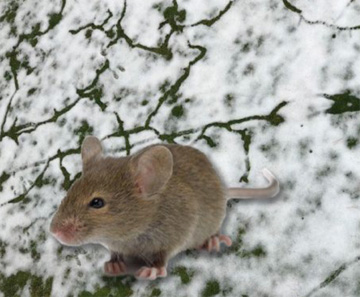MEADOW MICE THRIVE ON GOLF COURSE IN WINTER
By R.J. Smiley
Over the years “Critters On the Course” has shared a variety of stories and tales of the variety of critters that make their home on these man made oasis known as a golf course. This month we are going to take a look at one of the lowliest critters that call the golf course their home. We golfers seldom see these critters. During the winter months they are never in sight. The only time we even know they were there is when we see their exposed trails as the snow is melting. We see their tunnels, half in the snow and half in the grass just on top of the grass under the snow. In spring after the snow melts, but before the grass has started growing these winter freeways are very evident.
The meadow mouse or vole (also known as field mouse or jumping mouse) is an interesting creature. We are familiar with the term breeding like rats. In this case it would be breeding like meadow mice. These creatures are among natures most prolific.
Female meadow mice regularly have a litter of babies every month. The litters are usually four to five, but litters of ten or more are not uncommon. The babies are born hairless and helpless, but these babies mature very quickly. They develop fur within three days and are weaned at 12 to 14 days old. The babies are capable of breeding at one month and their mother’s breed almost immediately after giving birth. One female meadow mouse in a controlled captivity gave birth to 17 litters in a one year time period.
With all this breeding activity, the meadow mouse must stay nourished. The average mouse eats more than its body weight each day. A golf course provides the perfect diet every season of the year. They love bluegrass and poa annua, but will eat almost any type of grass or twigs. These voracious eating machines will eat seeds when they are available and have been known to eat insects.
One curious fact about meadow mice is that they have communal toilet areas at irregular intervals throughout their tunnel system. That is the reason why we find mouse droppings; there are a lot of those little black pellets. They remain very active year around.
It is apparent that if the meadow mouse were left unchecked, the population would soon take over the earth. These mice are the main food source of most of Minnesota’s meat eating critters. Many of the creatures that we enjoy watching while playing golf hang around because the food is easy to find. All types of hawks and owls eat meadow mice as well as larger rodents – if they can catch one. All members of the wildcat family love meadow mice. Domestic cats, that are allowed to roam free, many times hunt these mice at night. Cats that have been abandon and their offspring can survive on mice.
But my favorite critters that feed almost entirely on meadow mice are the often demonized coyote and their cousins the red fox.
The nature books are full of pictures of coyotes standing at attention with their backs arched. Then jumping straight up and landing with their nose buried deep in the snow or prairie grass and coming up with a tasty young meadow mouse. The keen sense of smell and hearing enable these predators to locate and capture mice by the thousands.
This spring when you play an early round keep your eyes peeled for the trails of our friends the meadow mouse.



